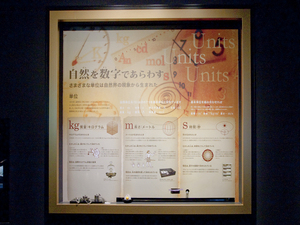Nagoya City Science Museum
TOP > Exhibition Guide > Keyword Search > Starting with "I" > international system of units > Units
Units



Purpose of Exhibition
Science has unraveled a variety of natural phenomena. It is very important to see how various physical quantities are indicated. You can understand how units such as length and weight are defined.
Additional Knowledge
If the definition of 1 meter differs depending upon the region, you will have some difficulties. If the unit for length is not only meter but other forms of measurement mixed up, some confusion occurs. To establish units, we have made a great deal of effort throughout history.
[International Units Conference]
To unify any unit such as length and weight etc. internationally, a meter treaty was held by representatives of 17 countries in 1875. Japan joined the treaty members in 1886. An International Unit General Meeting was held based upon a meter treaty and we some contracts were made regarding various units so far. Units are for length, volume, and weight.
[International Units (SI)]
In the 11th International Units General Meeting, in 1960, we adopted the international units (abridged SI). SI is composed of units mixing seven basic units with those basic units. The seven basic units are as follows.
Note: B square of A in this sentence is indicated as A^B.
The meter (m): The metre, symbol m, is the SI unit of length. It is defined by taking the fixed numerical value of the speed of light in vacuum c to be 299 792 458 when expressed in the unit m/s.
The kilogram (kg): The kilogram, symbol kg, is the SI unit of mass. It is defined by taking the fixed numerical value of the Planck constant h to be 6.626 070 15 x 10^–34 when expressed in the unit J s, which is equal to kg m^2/s.
The second (s): The second, symbol s, is the SI unit of time. It is defined by taking the fixed numerical value of the caesium frequency , the unperturbed ground-state hyperfine transition frequency of the caesium-133 atom, to be 9 192 631 770 when expressed in the unit Hz, which is equal to s^–1.
The ampere (A): The ampere, symbol A, is the SI unit of electric current. It is defined by taking the fixed numerical value of the elementary charge e to be 1.602 176 634 x 10^–19 when expressed in the unit C, which is equal to A s.
The Kelvin (K): The kelvin, symbol K, is the SI unit of thermodynamic temperature. It is defined by taking the fixed numerical value of the Boltzmann constant k to be 1.380 649 x 10^–23 when expressed in the unit J K^–1, which is equal to kg m2 s^–2 K^–1.
The mol (mol): The mole, symbol mol, is the SI unit of amount of substance. One mole contains exactly 6.022 140 76 x 10^23elementary entities. This number is the fixed numerical value of the Avogadro constant, NA, when expressed in the unit mol^–1 and is called the Avogadro number.
The candela (cd): The candela, symbol cd, is the SI unit of luminous intensity in a given direction. It is defined by taking the fixed numerical value of the luminous efficacy of monochromatic radiation of frequency 540 x 10^12 Hz, Kcd, to be 683 when expressed in the unit lm W^–1, which is equal to cd sr W^–1, or cd sr kg^–1 m^–2 s^3.
Article by Yoshitaka Yamada, Curator
